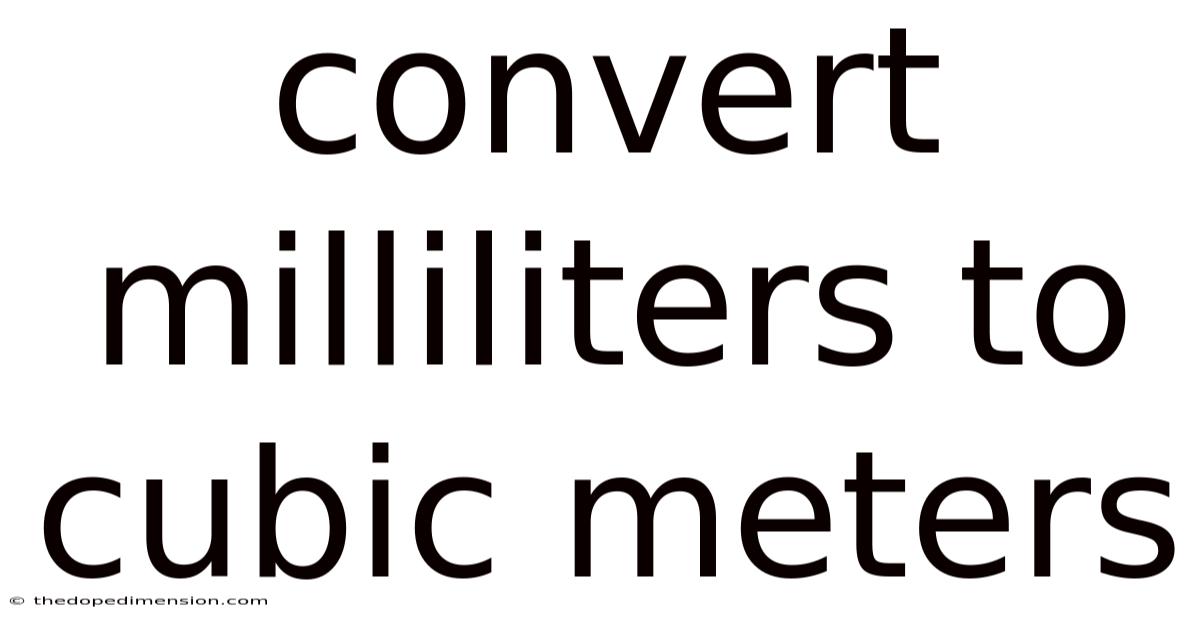Convert Milliliters To Cubic Meters
thedopedimension
Sep 12, 2025 · 4 min read

Table of Contents
Mastering the Conversion: Milliliters to Cubic Meters
Converting units of volume is a fundamental skill in many scientific, engineering, and everyday applications. Understanding how to convert milliliters (mL) to cubic meters (m³) is particularly important as it bridges a significant gap in scale. This comprehensive guide will not only walk you through the conversion process but also delve into the underlying principles, offer practical examples, and address frequently asked questions. By the end, you'll be confident in tackling any milliliter-to-cubic-meter conversion problem.
Understanding the Units: Milliliters and Cubic Meters
Before we dive into the conversion, let's establish a clear understanding of the units involved.
-
Milliliters (mL): A milliliter is a unit of volume in the metric system. It's a relatively small unit, often used to measure liquids in everyday contexts like cooking, medicine, and chemistry experiments. One milliliter is equal to one cubic centimeter (cm³).
-
Cubic Meters (m³): A cubic meter is a much larger unit of volume, representing the volume of a cube with sides of one meter each. This unit is commonly used for larger-scale measurements, such as the volume of rooms, buildings, or containers for transporting goods.
The Conversion Factor: The Key to Success
The core of converting milliliters to cubic meters lies in understanding the relationship between the units. There are 1,000,000 milliliters in one cubic meter. This is derived from the metric system's decimal nature. Let's break down how we arrive at this figure:
-
Meters to Centimeters: There are 100 centimeters (cm) in one meter (m).
-
Cubic Relationship: Since we're dealing with volume (three dimensions), we cube the conversion factor: (100 cm/m)³ = 1,000,000 cm³/m³.
-
Milliliters to Cubic Centimeters: As mentioned earlier, 1 mL = 1 cm³.
-
Combining the Conversions: Therefore, 1 m³ = 1,000,000 cm³ = 1,000,000 mL.
Step-by-Step Conversion Process
Converting milliliters to cubic meters involves a straightforward calculation using the conversion factor we've established. Here's a step-by-step guide:
-
Identify the Value in Milliliters: Begin with the volume you wish to convert, expressed in milliliters. Let's use an example: 500,000 mL.
-
Apply the Conversion Factor: Divide the value in milliliters by 1,000,000 (the number of milliliters in one cubic meter).
-
Calculation: 500,000 mL / 1,000,000 mL/m³ = 0.5 m³
-
State the Result: Therefore, 500,000 milliliters is equal to 0.5 cubic meters.
Practical Examples: Real-World Applications
Let's explore a few more examples to solidify your understanding:
-
Example 1: A water tank holds 2,500,000 mL of water. What is its volume in cubic meters?
2,500,000 mL / 1,000,000 mL/m³ = 2.5 m³
-
Example 2: A swimming pool has a volume of 150 m³. What is its volume in milliliters? (This involves the reverse conversion; simply multiply by 1,000,000)
150 m³ * 1,000,000 mL/m³ = 150,000,000 mL
-
Example 3: A chemist uses 75 mL of a solution in an experiment. What is the volume in cubic meters?
75 mL / 1,000,000 mL/m³ = 0.000075 m³
Scientific Explanation: Dimensional Analysis
The conversion process we've outlined utilizes a powerful technique in science called dimensional analysis. This method ensures that units are correctly handled during calculations, preventing errors. In our milliliter-to-cubic-meter conversion, we're essentially canceling out the "mL" unit by dividing, leaving us with the desired "m³" unit.
Frequently Asked Questions (FAQ)
-
Q: Can I use online converters for this conversion? A: Yes, many online converters are available that can perform this conversion quickly and easily. However, understanding the underlying principles is crucial for problem-solving and avoiding errors when online tools aren't accessible.
-
Q: What if I have a volume expressed in liters? A: First, convert liters to milliliters (1 liter = 1000 mL), then apply the conversion factor to get cubic meters.
-
Q: Are there any other relevant unit conversions related to volume? A: Yes, many! Other common volume units include cubic centimeters (cm³), cubic decimeters (dm³), cubic kilometers (km³), gallons, liters, and fluid ounces. Understanding the relationships between these units is helpful for various applications.
-
Q: Why is it important to understand these conversions? A: Accurate unit conversions are crucial in many fields, including engineering, medicine, chemistry, and physics, ensuring the correct measurements and calculations are used. Inaccurate conversions can lead to significant errors with potentially serious consequences.
-
Q: What about the concept of density in relation to volume? A: Density (mass per unit volume) often plays a role when working with volumes. Converting volume units correctly is essential for accurate density calculations.
Conclusion: Mastering Volume Conversions
Converting milliliters to cubic meters might seem daunting at first, but by understanding the underlying principles, the conversion factor, and the step-by-step process, it becomes a straightforward task. Mastering this conversion skill strengthens your foundation in scientific and mathematical reasoning, making you better equipped to tackle more complex problems in various fields. Remember, the key is to consistently apply the conversion factor of 1,000,000 mL/m³ and practice with various examples until you become confident and proficient. This understanding empowers you to solve problems accurately and confidently in many practical and scientific settings. Don't be afraid to work through examples and solidify your understanding – the rewards of mastering unit conversions are significant.
Latest Posts
Latest Posts
-
1500 Australian Dollar To Usd
Sep 12, 2025
-
Currency Converter Dirhams To Pounds
Sep 12, 2025
-
Qatar Currency Vs Us Dollar
Sep 12, 2025
-
4800 Sq Ft To Acres
Sep 12, 2025
-
Centimeter To Square Feet Converter
Sep 12, 2025
Related Post
Thank you for visiting our website which covers about Convert Milliliters To Cubic Meters . We hope the information provided has been useful to you. Feel free to contact us if you have any questions or need further assistance. See you next time and don't miss to bookmark.